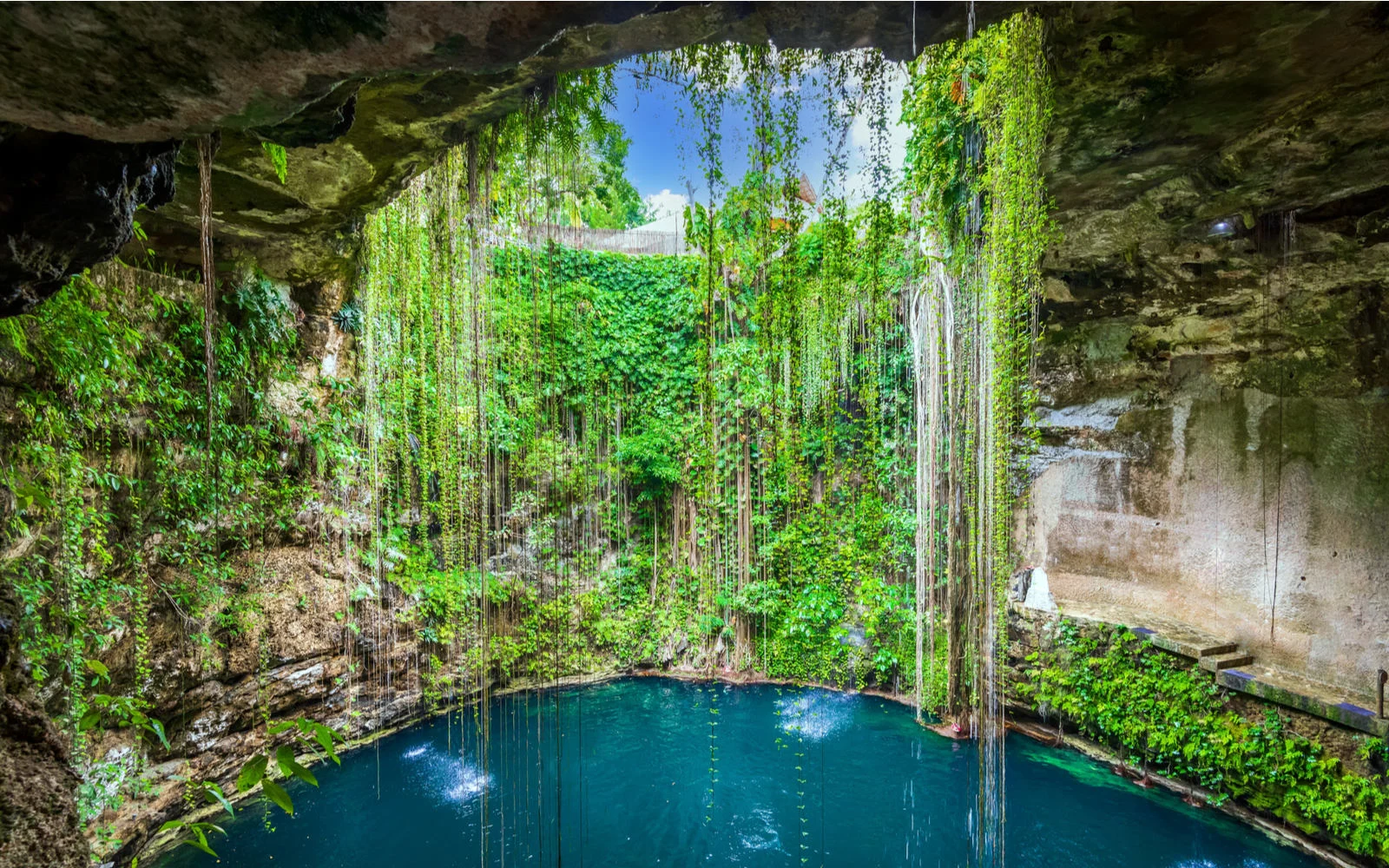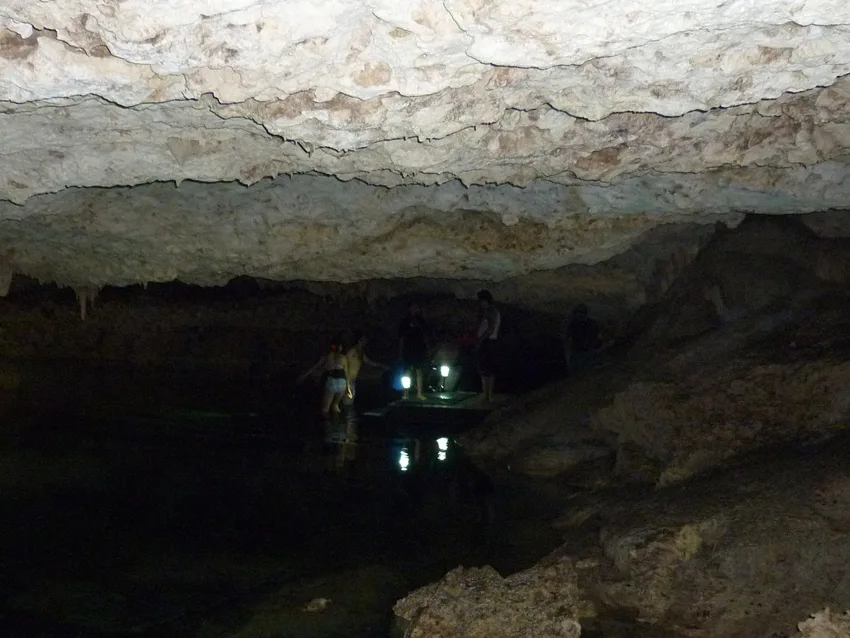There’s something magical about swimming in a cenote. Being surrounded by nature gives you the sense of adventure and wonder that always comes with exploring an unknown place, and Mexico is home to some of the best cenotes in the world. We’ll explore the 12 best in this guide.
What Is a Cenote?
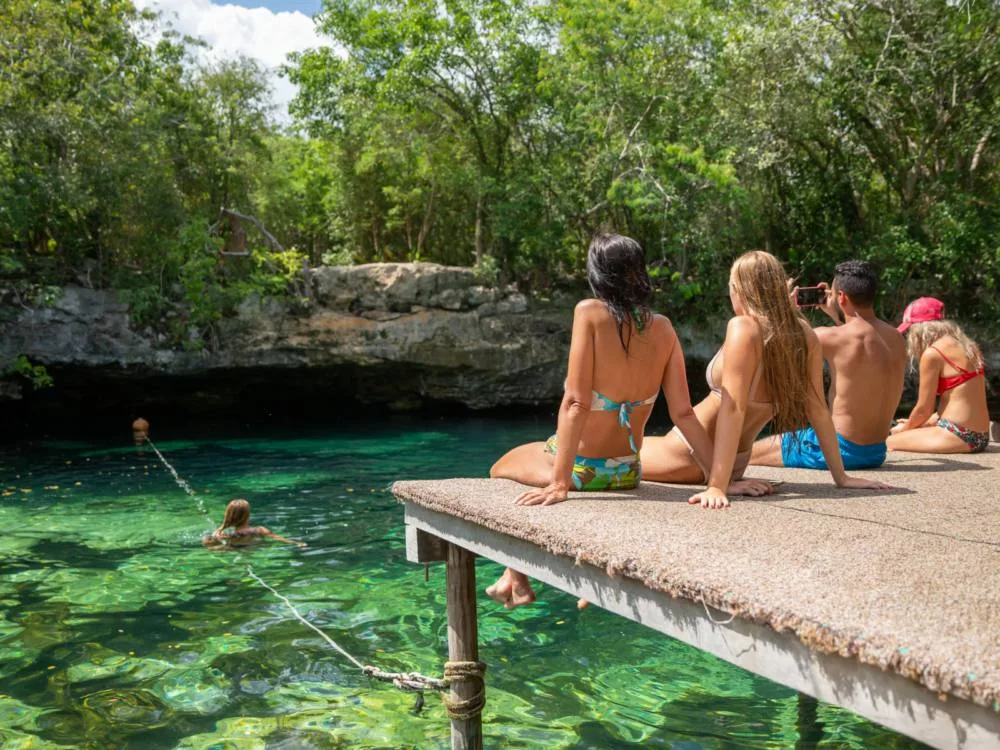
Mike Fouque/Shutterstock
Swimming in a secluded cenote is will be one of the highlights of your trip to Mexico. But before we explore the best cenotes in Mexico, let’s take a closer look at what these natural swimming holes are.
Cenotes (pronounced seh-no-tay) are natural swimming holes, usually formed in a natural sinkhole or pit after a limestone bedrock collapse. These cool features are surface level connections to subterranean bodies of water that continue deeper underground. There are around 10,000 of them in Mexico, especially concentrated on the Yucatán Peninsula.
There are multiple types of cenotes, but the most common types you’ll see are open, semi-open, and closed cenotes. The difference lies in what’s above or over the cenote — if it’s open to the sky, it’s an open cenote. If it’s partially or completely enclosed by rock or a cavern, it’s a semi-open or closed cenote.
Cenotes have a long cultural history in Mexico, serving as both a water source and sacred sites where human sacrifices to the Mayan god Chaac were performed.
Warriors, children, and women were flung into the natural wells during these ceremonies along with precious valuables to appease the god. That’s why you’ll find so many incredible Mayan ruins around Mexico’s cenotes, adding to your day of adventure and fun.
Today, the use of cenotes is much less dark. People come to swim, admire, and immerse themselves in the eerie and fascinating history of these sparkling pools that seem to appear suddenly out of the surrounding jungle.
If you’re ready to check out some of the best cenotes in Mexico on your upcoming trip, take a look at our top picks below.
The 12 Best Cenotes in Mexico in 2025
With over 10,000 estimated cenotes scattered across Mexico’s Yucatán Peninsula, figuring out which ones are actually worthy of a visit presents a challenge.
What are the best cenotes in Mexico to visit? And what makes the top choices stand apart from the thousands of others you’ll find in this jungled terrain dotted with ancient Mayan ruins?
From the famous Gran Cenote to the lesser-known (but equally captivating) Angelita Cenote, you’ll find a spot you can’t wait to explore on this list.
1. Dos Ojos – Tulum
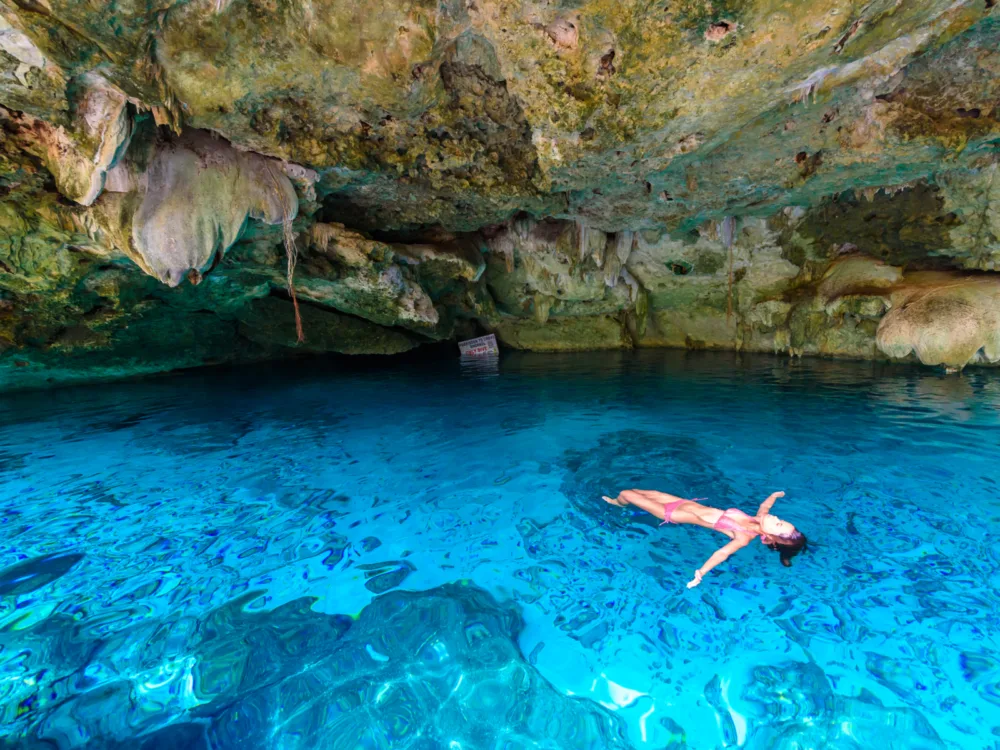
Simon Dannhauer/Shutterstock
What’s better than one cenote? Two! Dos Ojos is a site with twin semi-open cenotes (Bat Cave and the Barbie Line) north of Tulum in Quintana Roo, Mexico. Dos Ojos translates to “two eyes.”
The cenotes are surrounded by stalagmites and stalactites as the cavern yawns overhead. Fish and wildlife like freshwater jellyfish and cave shrimp fill the pools.
This is a popular dive site (always with a guide) because the waters inside the cenotes are crystal clear with excellent visibility. In the larger Bat Cave cenote, you’ll find a colony of bats hanging upside down, adding an eerie element of adventure to your swim or dive.
The Barbie Line is a bit more shallow than the Bat Cave, shallower, and perfect for taking a diving lesson or experiencing the seclusion of the cenotes if you’re a bit nervous about taking on the Bat Cave.
- Hours: 8AM-5PM daily
- Entry Fee: $14/200 pesos
- Swimming: Yes; snorkeling & diving packages available through tour operators
2. Gran Cenote – Tulum
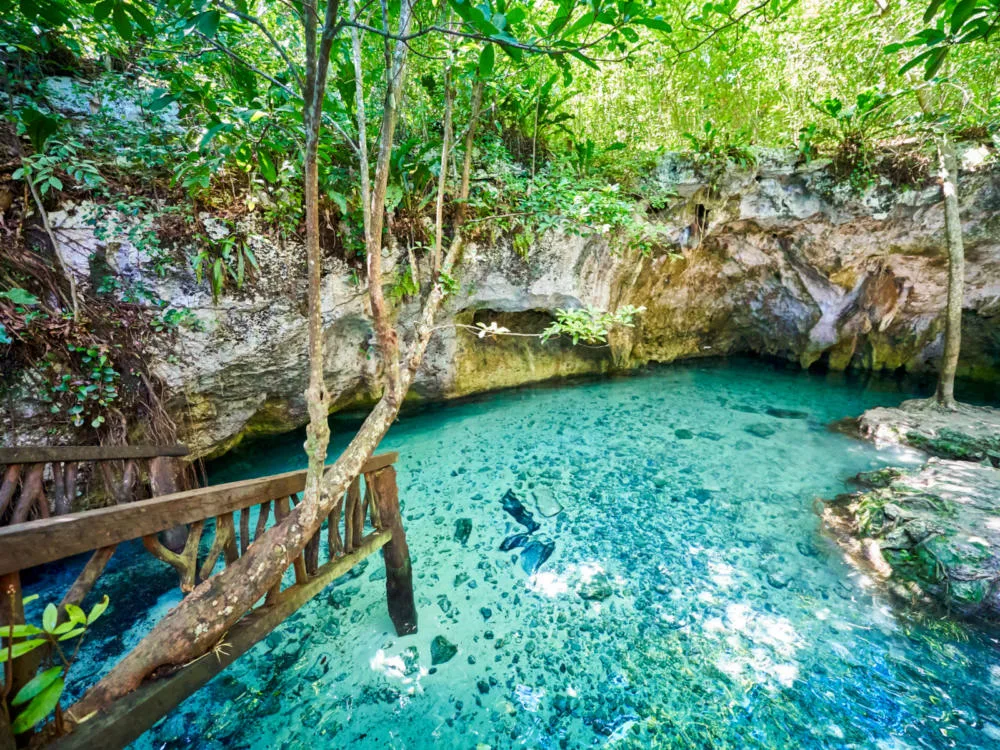
Niarkrad/Shutterstock
Also near Tulum, the semi-open Gran Cenote is around 200 feet deep. It’s a tourist favorite that’s close to the Caribbean Sea and absolutely stunning to see and experience in person with its vibrant aquamarine color contrasting with the jungle around it.
The system actually contains several cenotes that open up in the floor of the jungle as subterranean lagoons surrounded by lush vegetation. Each of the cenotes in Gran Cenote are conveniently connected by wooden pathways so you can cenote-hop your way through the area.
Inside Gran Cenote, you’ll see lots of fish and small Meso-American slider turtles swimming and lounging, adding to your enchanted experience while you’re swimming or snorkeling in the clear waters.
The cenotes here open up to an unfathomably deep and massive cave system deeper underground, which is especially fun if you rent snorkeling or diving equipment to get a closer look.
You’ll want to plan your visit to Gran Cenote carefully, setting out as early as possible to avoid the large crowds that descend on the pools in the mid-morning and afternoon. It’s so much more enjoyable to be able to experience the cenotes without being surrounded by crowds.
- Hours: 8AM-5PM daily
- Entry Fee: $25/500 pesos
- Swimming: Yes; snorkeling & diving equipment rentals available
3. Cenote Yaxmuul – Tulum
Located just 15 minutes north of the ancient Mayan city of Tulum, Cenote Yaxmuul is another swimming and diving hotspot that offers gorgeous cavern and water views with tons of stalactites and stalagmites around you, showing the cave’s long-spanning natural history.
There are actually two cenotes in this system: Yax-Muul (larger and deeper) and Sac Tuunich (smaller and shallower). Jungle flora and fauna surround you and really envelop you in the peninsula’s unique beauty.
Vivid turquoise waters lurk beneath the surface, only showing their color thanks to a circular spot of light from the opening above. Further back, you can enjoy the shade and a quiet moment of solace as you float, swim, or snorkel in this majestic chamber.
There are lots of tour and activity options when you visit Cenote Yaxmuul, including rappelling, swimming, snorkeling, and diving with options to see a reenactment of a Mayan ceremony once you arrive at the site. There are great facilities onsite, offering restrooms, tours, rental equipment, and more.
- Hours: 9AM-4PM daily
- Entry Fee: $37/700 pesos
- Swimming: Yes; snorkeling, diving, & rappelling packages available
4. Casa Cenote (Cenote Manatí) – Tulum
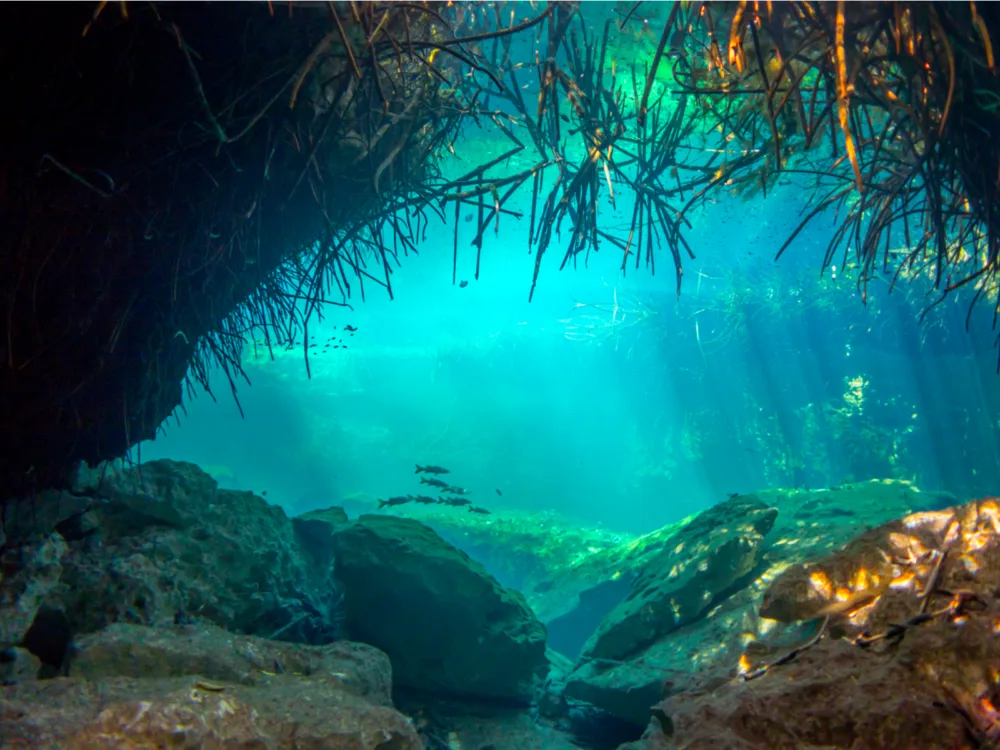
Sabrina Inderbitzi/Shutterstock
Casa Cenote, or Cenote Manati (Manatee) is really unique and one of our favorite spots to swim and snorkel. Unlike other cenotes, this one winds through a dense mangrove forest and has a snake-like shape. A family of manatees once called it home (hence the nickname), but they’ve since moved on.
Casa Cenote (an open cenote over 800 feet long) connects to the ocean, making the water inside brackish and home to incredibly varied wildlife that you won’t find in other cenotes.
Panchito, the resident crocodile, is known to swim in the cenote (he’s said to be friendly, just don’t get too close). Where else can you say you’ve been swimming in a cenote with a croc?
There are large fish, blue crabs, and turtles that make their way through this fascinating natural swimming hole with shallow waters. Swimming upstream will give you quite a workout with the powerful current, allowing you to gently float on your way back out.
Shine your flashlight across the halocline, which appears like a deeper lagoon in another shade of blue where the salt water mixes with the freshwater inside the cenote. It’s a truly astounding sight!
Facilities onsite are great and make it convenient to spend a few hours exploring and snorkeling around the cenote. There are lockers to stow your stuff, life jacket and kayak rentals, restrooms, and more to make the most of your trip. Diving tours can be scheduled across the street!
- Hours: 9AM-5PM daily
- Entry Fee: $9/150 pesos
- Swimming: Yes; snorkeling, diving, & kayak packages rentals available
5. Cenote Oxmán – Yucatan
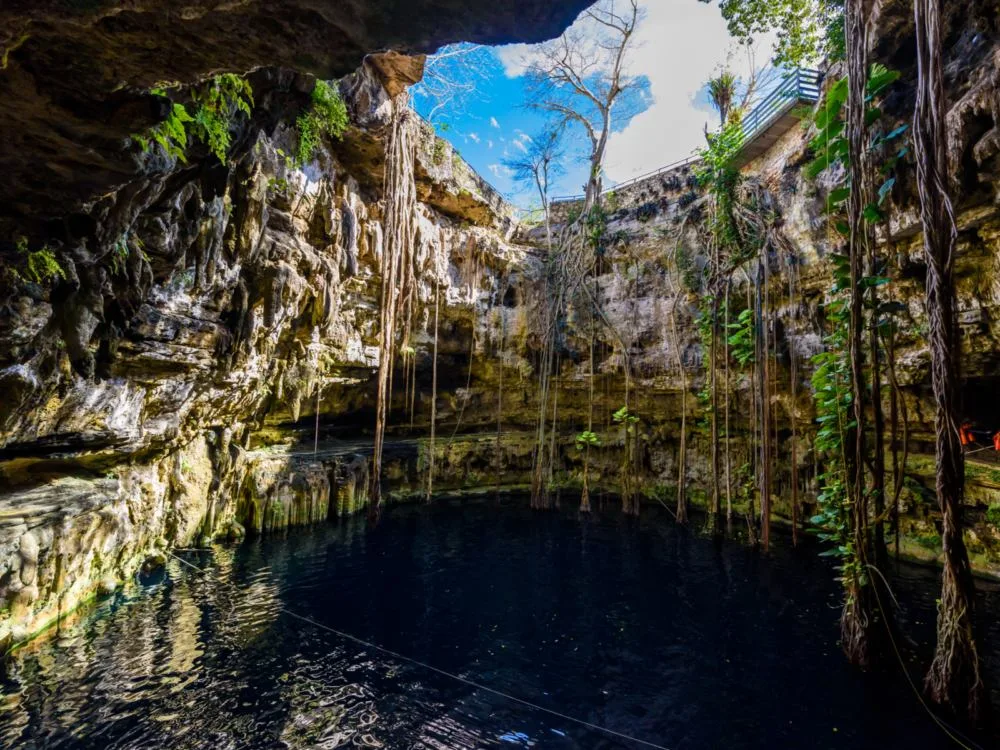
Simon Dannhauer/Shutterstock
On the grounds of Hacienda San Lorenzo Oxman, a historic home-turned-restaurant from the 1700s surrounded by lush gardens, you’ll find the magical Cenote Oxman. Vines and tree roots hang down into the opening and give the site an ancient, almost mystical feel.
Inside the cenote, the waters are clear, deep blue, and dappled with sunlight that streams through the surrounding trees and plants. It’s one of the best spots to snorkel and swim, and there’s a rope swing secured in place if you want to swing out and jump in!
Scuba diving isn’t allowed here, but you’ll appreciate donning a snorkel and mask to see the small fish that swim in the clear waters below you. The waters are so clear, you can see straight to the bottom when you swim!
Head up to the viewing platform for a better perspective of the cenote as a whole, or get right into the action by walking along the paths that encircle the cenote. Floating inside the cenote, you can get directly under the opening and see the sky overhead.
You’ll find thatched palapa umbrellas and seating around the swimming area to get out of the sun. Facilities here are great, including restrooms, changing rooms, and outdoor showers near the entrance.
Cenote Oxman is open daily from 8:00 AM to 5:00 PM. The entrance fee is approximately 150 Mexican pesos per person. Alternatively, you can pay 200 pesos and get a voucher at the on-site restaurant. Cash is typically the only accepted form of payment, so make sure to have local currency on hand.
- Hours: 8AM-5PM daily
- Entry Fee: $9/150 pesos
- Swimming: Yes, but no diving; bring your own snorkeling equipment
6. Cenote Angelita – Tulum
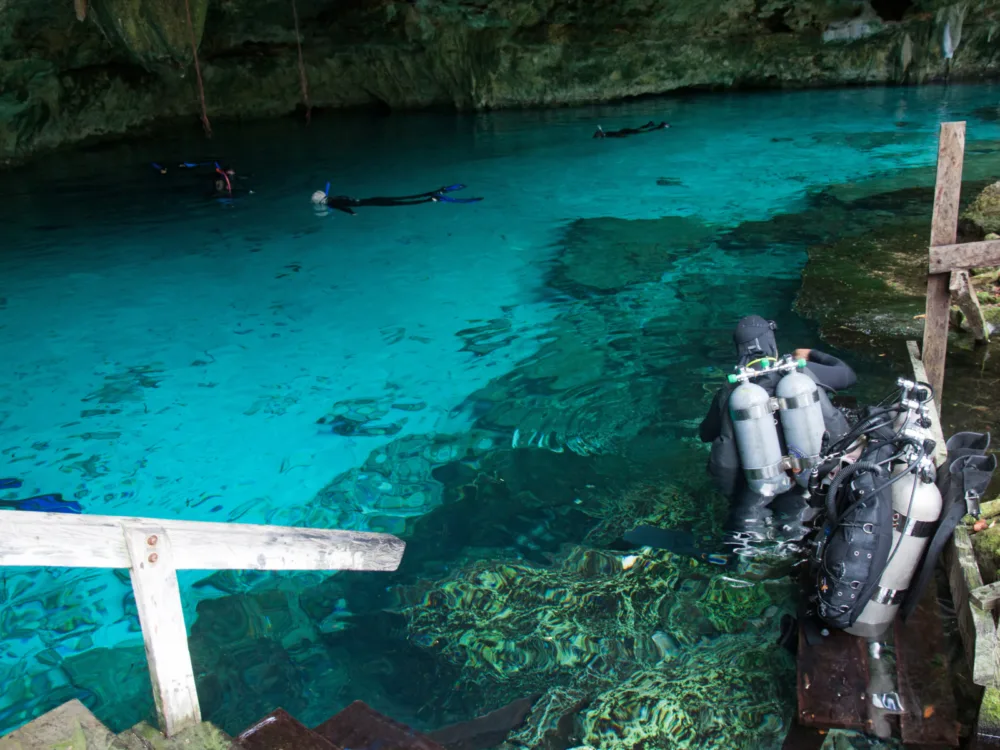
Morenovel/Shutterstock
Appearing like a small lagoon in the jungle, Cenote Angelita (“little angel”) is fed by a subterranean river and is popular to visit for experienced divers and those who want to see the amazing halocline where water visibly divides itself into “layers” of salt and freshwater.
Located just 15 minutes south of Tulum, reaching the stunning Cenote Angelita involves a walk through the jungle before you arrive at its circular opening in the ground, plunging nearly 200 feet down.
Clear freshwater rests on top while a cloudy layer of hydrogen sulfate and salt water further down creates a visible divide. Tree roots and branches tangle through the deeper layer, which is so deep that sunlight struggles to penetrate it.
Experienced divers (with at least 20 dives under their belt) love coming here for technical dives because of its depth and unique environment.
There are large stalactites that appear to drip from the edges of the cenote, making it a truly fascinating place to visit, even if you won’t be diving.
- Hours: 8AM-5PM daily
- Entry Fee: $6/100 pesos; $18/300 pesos to dive
- Swimming: Yes; experienced swimmers and divers only
7. Cenote Ponderosa – Quintana Roo
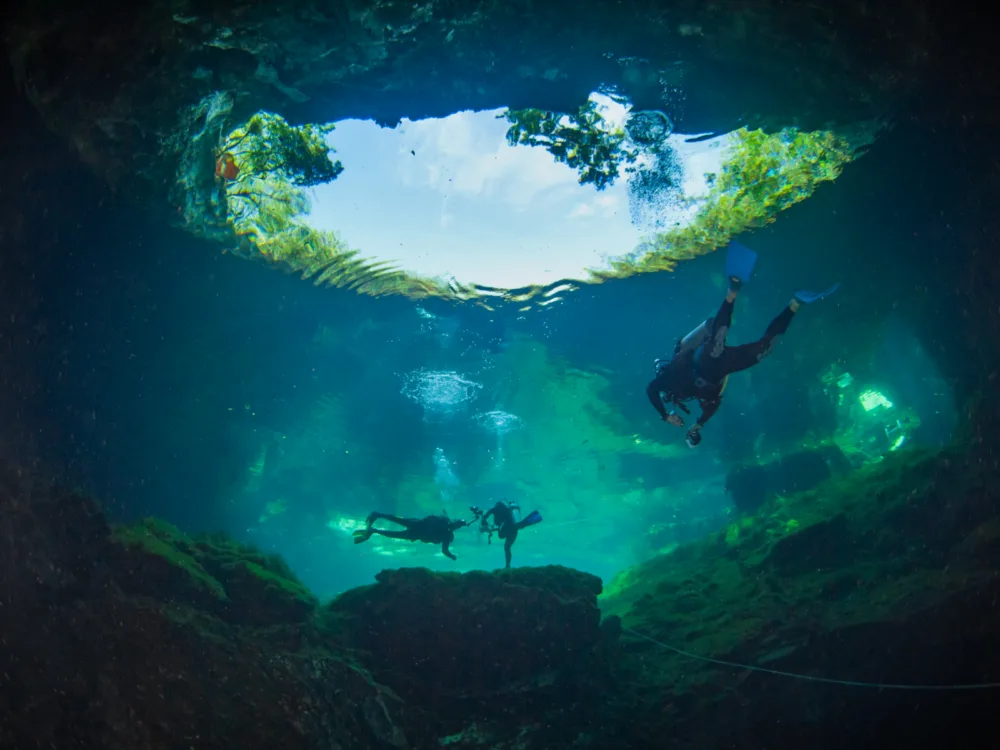
Mayumi.K.Photography/Shutterstock
Cenote Ponderosa is located in the middle of the jungle about 20 minutes from Playa del Carmen, a sparkling and crystal-clear freshwater pool surrounded by dense vegetation and filled with underwater rock formations.
You might hear it called by a host of other names: Cenote Jardin del Eden, Cenote Garden of Eden, or Cenote Eden. The entire cenote is surrounded by cliffs that are popular to jump off into the waters below!
It truly does remind us of the Garden of Eden. The rocks under the amazingly clear water are draped in soft moss, verdant greenery surrounds the pool on all sides, and the brilliant blue of the water pops with contrast in this jungled setting.
You can see all the way to the bottom of this open cenote, and you’ll find suitable areas for shallow swimming and snorkeling (you can even bring the kids!) and deeper zones on the opposite end for diving all the way into the cave it connects to. You’ll pass huge boulders and through tunnels during your dive.
Garra rufa fish are everywhere inside the cenote, coming up to gently nibble on your toes while you float. Swimming scares them off, so if you’re not into the “free pedicure,” just keep moving!
- Hours: 9AM-5PM; closed Saturdays
- Entry Fee: $12/200 pesos (adults); $5/100 pesos (kids)
- Swimming: Yes; diving and snorkeling packages available
8. Cenote Suytun – Valladolid
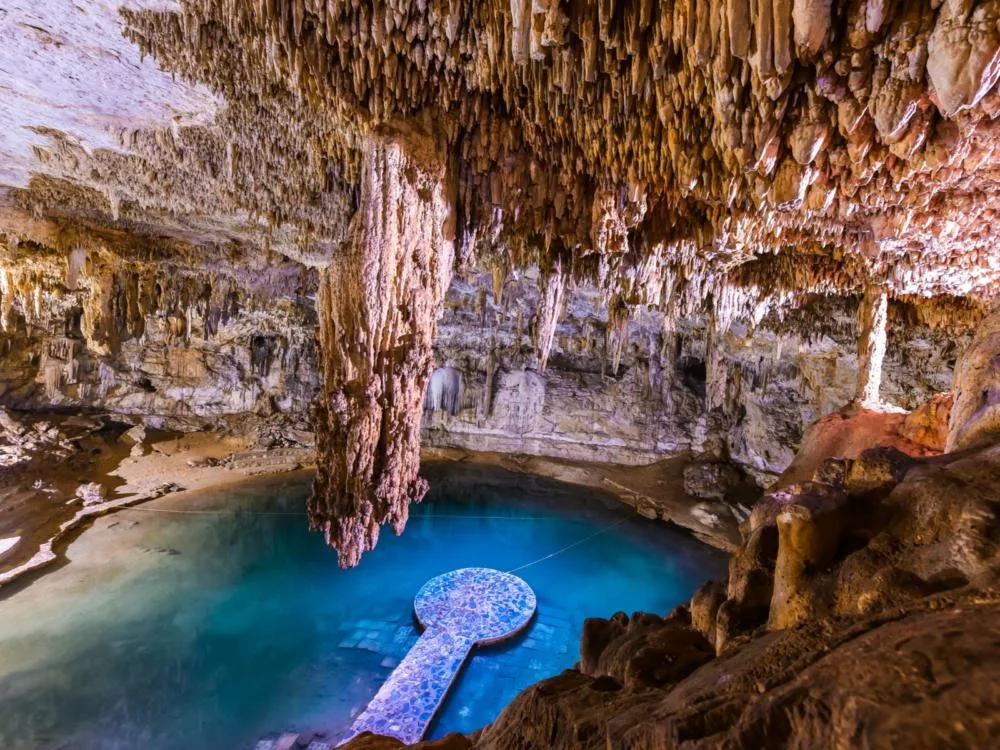
Simon Dannhauer/Shutterstock
For a truly unforgettable experience, visit Cenote Suytun just east of Valladolid. This is a semi-open cenote, with only a sliver of sunlight streaming through a small opening at the top. You’ll feel like you’re in an enchanted cavern world inside.
People clamor to get to the platform just under the opening, shaped a bit like a key and the perfect spot to get a photo of yourself enjoying the cool subterranean world of Cenote Suytun. You’ve probably seen pictures on Instagram of this very spot!
There are huge stalactites hanging from the top, giving the cave an interesting and almost dangerous appearance as the columns jut out from the ceiling of the cave. Researchers believe the cave was once used for ceremonies and sacrifices due to discoveries of bones and artifacts at the bottom.
While the knowledge of bones and ancient artifacts can add a spooky element to the cenote, you’ll be overwhelmed by the sheer beauty and atmosphere within this subterranean chamber. The water is cold, so you won’t want to swim for long, but it’s quite an experience.
Crystal-clear waters make ideal conditions for snorkeling, and there are plenty of small fish circling the cenote as well as cool underwater rock formations that you can catch a glimpse of during your visit.
- Hours: 9AM-5PM daily
- Entry Fee: $6.50/120 pesos
- Swimming: Yes; snorkeling allowed, but no diving
9. Cenote Zacil-Ha – Valladolid
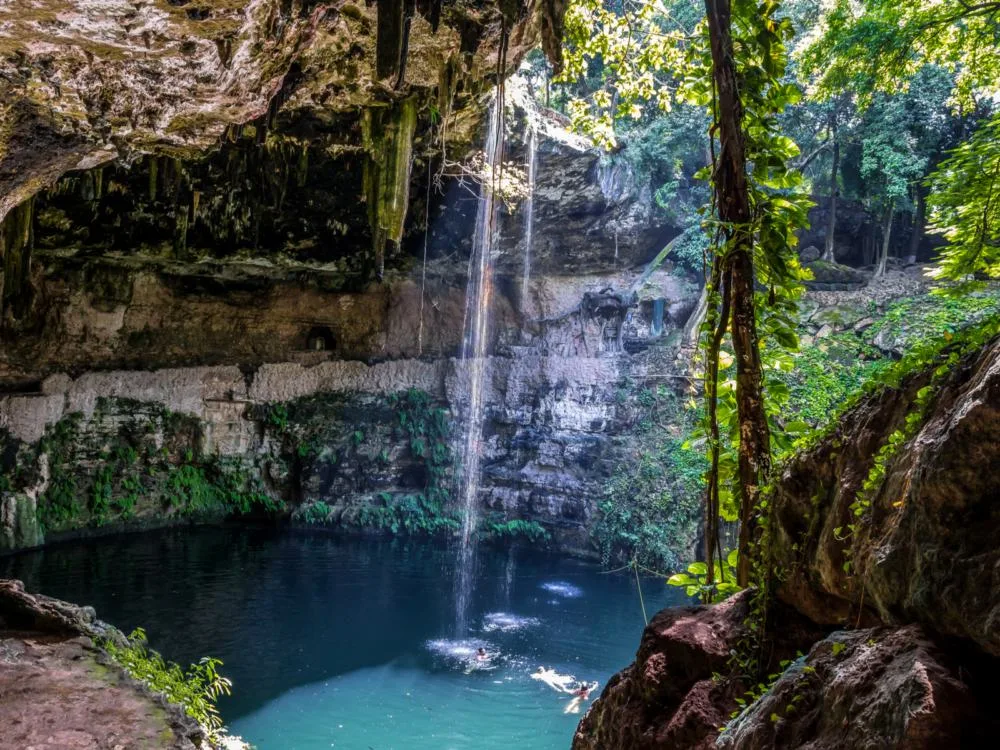
Diego Grandi/Shutterstock
Cenote Zacil-Ha is a smaller, but visually stunning, cenote you’ll find near Tulum with shallow waters that make it a favorite spot for swimming and snorkeling, even with kids in tow.
On average, this cenote is only around 9-10 feet deep. If you’re comfortable swimming in a pool, you’ll be comfortable getting into the clear, brilliant blue waters here! With great visibility due to the water clarity, snorkeling is a lot of fun and you’ll be able to see lots of tiny fish and rocks under the water.
The plants, vines, and hanging roots overhead combined with varying shade from the overhanging cliff make this a scenic and fun spot to hang out.
There’s a zip-line running across the top of the cenote, so if you’re up for a different type of adventure, you can give it a go! The zipline ends with you making a big splash into the water beneath you.
Hang out on the surrounding decks with thatched palapa umbrellas and lounge chairs that make the area supremely comfy for spending the morning or afternoon. You can even pack a picnic to enjoy!
- Hours: 9AM-5PM daily
- Entry Fee: $12/200 pesos
- Swimming: Yes; snorkeling and zip lining available
10. Cenote Azul – Playa del Carmen
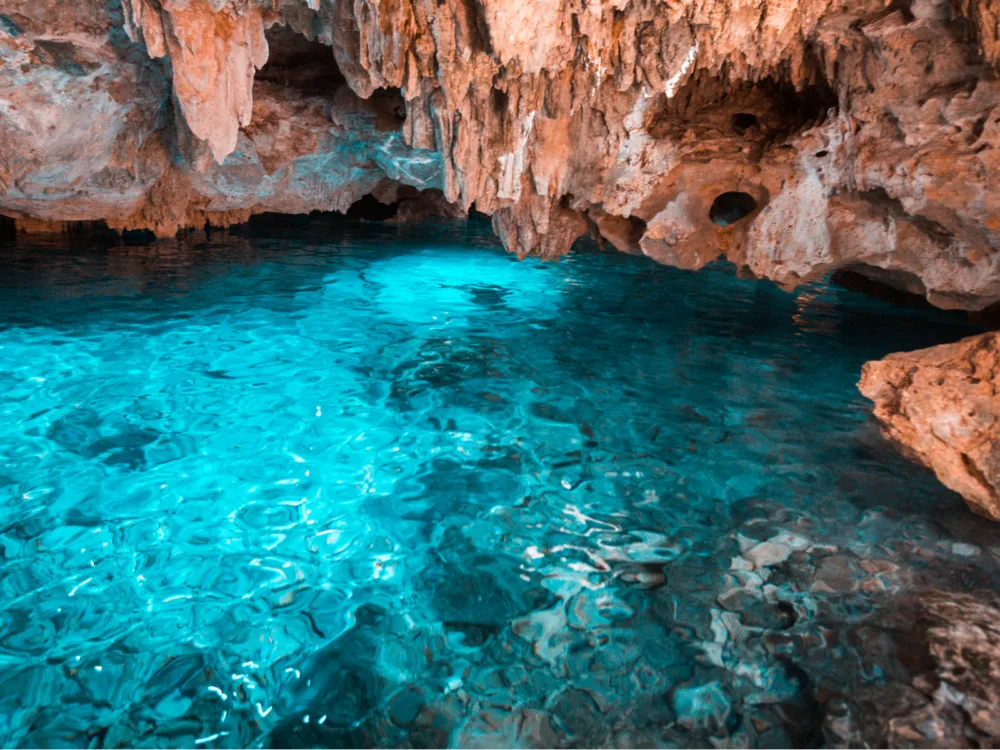
Tom Ha/Shutterstock
Just 30 minutes north of Tulum is Cenote Azul (translating to “Blue cenote”), an open cenote that is a popular place for swimming for all ages. Shallow, clear water with amazing limestone rock formations are the main features of the two cenotes at this site.
As you enter along a shaded jungle path, you’ll encounter two small pools where kids can splash among the rocks in very shallow water. Continue on to the main cenote swimming area, where you’ll find two cenotes: One shallow, one deeper.
The shallow cenote is perfect for lounging in the water on a warm day. You can sit in the water on top of huge rocks, where only your legs are submerged. The deeper cenote has low cliffs around it that are often used for cliff jumping. Try it yourself or watch others leap into the cenote!
A raised walkway connects both cenotes for easy travel back and forth. If you bring snorkeling equipment, you’ll enjoy exploring the deeper cenote (no flippers are allowed here). Life jacket rentals are available at the entrance, where you’ll also find changing rooms and restrooms.
- Hours: 8:30AM-5:30PM daily
- Entry Fee: $9/150 pesos (adults); $6/100 pesos (kids)
- Swimming: Yes, but not deep enough for diving
11. Cenote Siete Bocas – Puerto Morelos
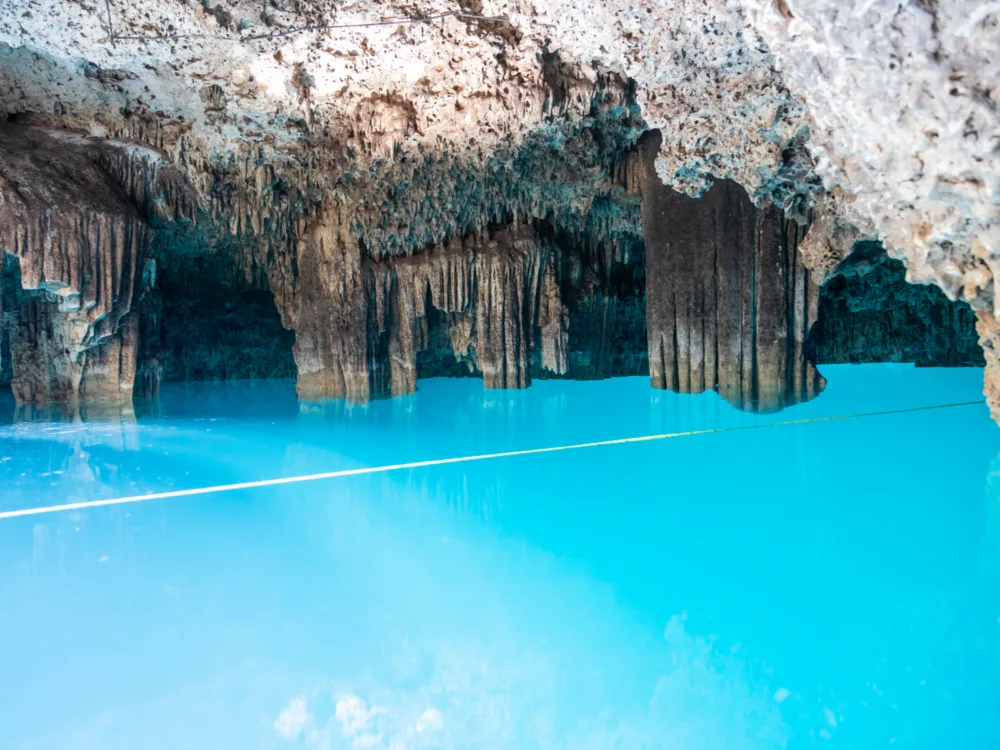
Iren Key/Shutterstock
Cenote Siete Bocas features 7 different “pools” or access points at different depths, offering places to swim in more shallow water or dive and jump into deep pools. They are beautiful as sunlight filters through the openings and lights up the water with vibrance.
Take the gravel path down to the cenote from the entrance to reach the swimming area. Entering the cenote is as simple as descending a ladder or jumping from a low cliff into the depths.
There are beautiful rocks under the water with awe-inspiring cavern formations, like stalactites and columns, that reach down from the ceiling. Bring your own snorkeling equipment if you want to get a better look at what’s going on under the surface.
Life jackets are required to swim in the cenotes because the water is very deep in spots. You’ll find cenote #3 the best for cliff jumping! After your swim, you can hang out in the loungers surrounding the cenote and dry off in the warm sunlight.
Restrooms and changing rooms are onsite for your convenience (and this makes it easier to spend a few hours enjoying the cenotes and the surrounding scenery).
Reviews differ on the current entry fee — some have reported that you have to “haggle” with the operator, with amounts ranging from $20-$25 per adult to enter.
- Hours: 8AM-5:30PM daily
- Entry Fee: Ranges from $20-25/340-430 pesos
- Swimming: Yes; bring your own snorkeling equipment
12. Cenote Calavera – Tulum
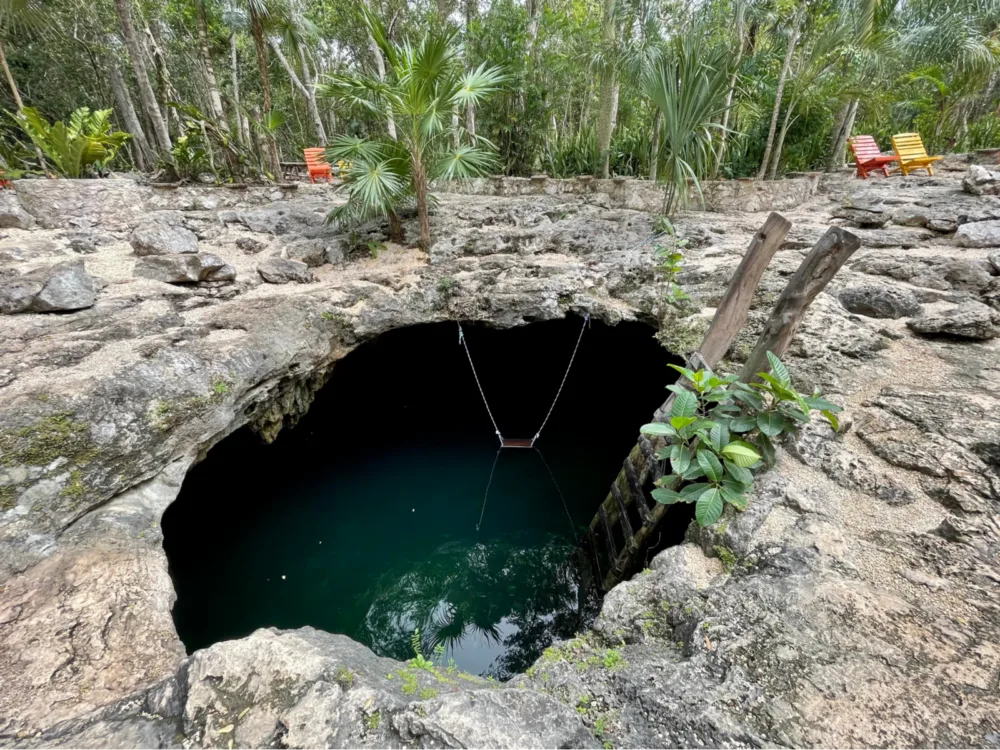
Mala Iryna/Shutterstock
Cenote Calavera, or “Skull Cenote,” is sometimes called the Temple of Doom. Why? There are 3 openings in the top of the cavern where the cenote is partially hidden underneath, forming the shape of eyes and a mouth, much like a skull.
You’ll feel no trace of doom as you enter the cenote, however — this is a place of fun and adventure! It’s part of the Sac Aktun cave system that spans much of the Mayan Riviera, dotted with cenotes the entire way.
Located in the dense jungle just 5 minutes from Tulum, it’s easy to reach if you’re in the area and boasts an incredible halocline, or visible water divide between fresh and salt water, about 40 feet down.
This is a semi-open cenote with openings at the top where sunlight filters through, lighting up the interior and water for a stunning glimpse of the watery world below.
There’s a ladder you can climb up (careful, it can be slippery) to reach a platform where you can jump into the depths. Or use the cool rope swing to swing out and make a big splash!
- Hours: 8:30AM-5PM daily
- Entry Fee: $15/260 pesos
- Swimming: Yes; diving packages available from tour operators
Things to Consider
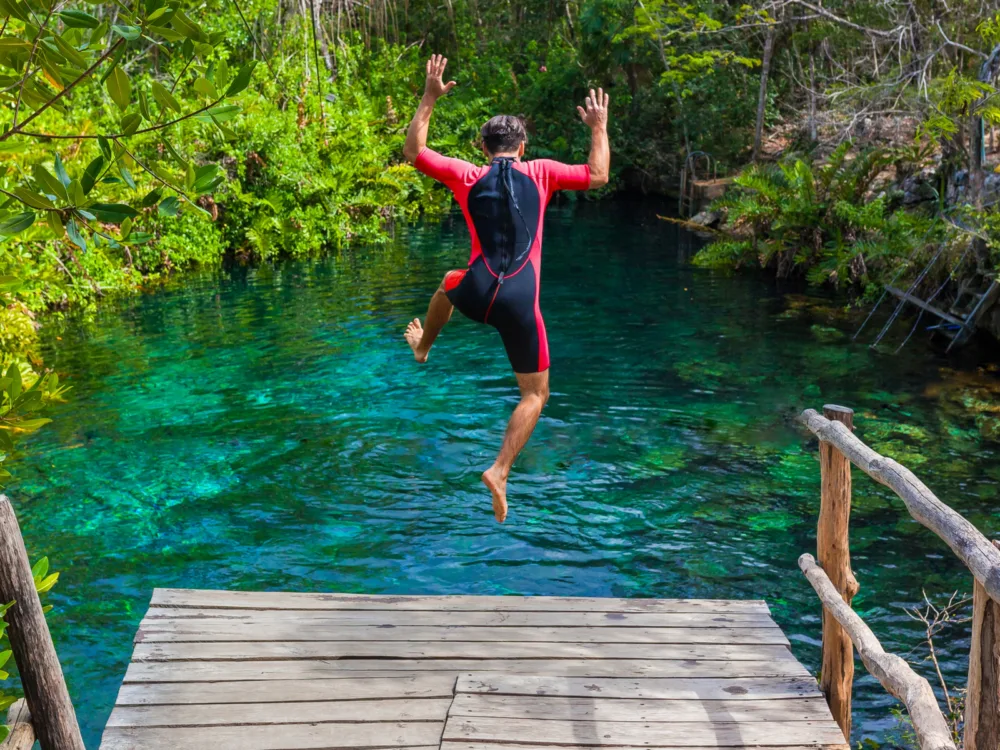
Martin Corr/Shutterstock
Planning to check some of the best cenotes in Mexico off your list during your upcoming trip? Keep the following pointers and tips in mind to make the most of your journey.
- Don’t wear regular sunscreen or bug spray. Cenotes are fragile, protected ecosystems that can easily be thrown out of balance when swimmers wear chemical-laden sunscreens or insect repellants when they get into the water. Choose a reef-safe sunscreen if you need the UV protection and avoid using bug spray, scented lotion, tanning oils, etc. before your swim. If there’s an outdoor shower available, use it before you get into the water.
- Bring water shoes. Many cenotes feature sharp, algae-slicked, and irregularly shaped rocks on the sides and bottom of the pools, which can make it dangerous, slippery, or uncomfortable to swim or make your way in and out. While some cenotes will have water shoes to rent, you’re better off bringing your own to ensure you’ve got them and can protect your feet while adding more grip.
- Don’t touch the wildlife. Small fish may come up and nibble on your toes, and you could see iguanas, turtles, crabs, and even crocodiles when you’re visiting some of the best cenotes in Mexico. Resist the temptation to interact with the wildlife and don’t touch or interfere! Snap photos, but don’t disturb the creatures you may find in and around the cenotes to leave the fragile ecosystem intact.
- Set out early. The earlier you set out for your cenote adventures, the less crowded and more enjoyable your visits will be. Tour operators tend to bring large crowds of tourists around mid-morning and afternoon time slots, so getting out before everyone else will give you a more secluded, realistic experience in the cenotes without having to wait your turn.
What to Bring
Visiting a cenote in Mexico means coming prepared! There are different types of facilities and amenities at each one, so to be on the safe side, make sure you’ve got the following items in your pack.
- Swimwear: Comfortable swimsuit that won’t lead to a wardrobe malfunction if you decide to jump or swing into the water
- Towel: While some cenotes offer towels after your swim, not all do and it’s a must if the water was chilly
- Life jacket: Many cenotes offer life jacket rentals with your entry, but bring one if you’re not a strong swimmer
- Water shoes: Rocky bottoms, fish nipping your toes, sharp edges, and slick surfaces make water shoes essential in cenotes
- Snorkel and mask: Snorkel mask and snorkel for viewing underwater wildlife if equipment rentals aren’t available
- Waterproof flashlight: Handy for closed and semi-open cenotes where visibility is difficult in dark and shaded areas
Frequently Asked Questions

Florian Augustin/Shutterstock
What else should you know about these mystical natural pools before you set out to visit all the best cenotes in Mexico? Take a look at traveler’s most frequently asked questions below to learn more.
What is the most beautiful cenote in Mexico?
Cenote Siete Bocas is widely regarded as one of the most beautiful cenotes in Mexico, owing to its 7 openings that allow sunlight to stream through the top and hit the turquoise water below. There are stunning cave formations inside, including massive stalactites and rock columns, that give it a magical feel.
Cenote Ponderosa, also called the Garden of Eden cenote, is another contender for the most beautiful cenote in Mexico. Surrounded by lush jungle flora and featuring amazingly clear water with lots of vegetation, rock formations, and tiny fish inside make it a gorgeous cenote to swim and snorkel in.
Is it safe to swim in cenotes in Mexico?
It depends. Some cenotes are safe to swim in and bathers are allowed to swim, snorkel, and even cliff jump or use a rope swing to get into the water. Others are considered sacred or dangerous and swimming is not allowed, like the Sacred Cenote at Chichen Itza (which has stagnant water).
Where are the best cenotes in the world?
The best cenotes in the world are in Mexico on the Yucatan Peninsula. With an estimated 10,000+ cenotes scattered around the peninsula due to the limestone bedrock and massive cave networks here, cenotes are very common and are often located at the heart of Mayan ruins.
What is the biggest cenote in Mexico?
The biggest cenote in Mexico is the Nohoc Nah Chich cenote, which marks the entrance to the huge Sac Aktun cave system that leads 229 miles deep into the earth and is the basis for over 200 cenotes throughout the system.
Sac Aktun is the longest underwater cave system that has been surveyed in the world. It’s giant opening, the Nohoc Nah Chich cenote, extends deep into the earth and takes the spot of Mexico’s biggest cenote -- and perhaps, the biggest in the world.
What is the most picturesque cenote?
Gran Cenote, Cenote Oxman, and Casa Cenote are considered some of the most picturesque cenotes. They are all popular cenotes to visit and you’ll see great photos of each one posted on Instagram because they’re so beautiful and picturesque.
Their cave formations, including stalactites and stalagmites, as well as hanging vines and roots, surrounding jungle flora, and filtered sunlight through openings or long, winding shapes that open up to mangrove forests make these the most scenic and beautiful cenotes in the country of Mexico.
So, What Are the Best Cenotes in Mexico?
| 👍 Best Overall | Dos Ojos in Tulum |
| 🤿 Best for Snorkeling | Gran Cenote in Tulum |
| 👨👨👧👦 Most Popular | Cenotes Yaxmuul in Tulum |
| 🌤️ Best Open-Sky Cenote | Casa Cenote in Tulum |
The best cenotes in Mexico are scattered around the Yucatán Peninsula, ranging from open, snaking pools that look like miniature rivers through mangrove forests (like Casa Cenote) to partially enclosed, subterranean chambers with amazing stalactites and rock formations (like Cenote Suytun).
Whether you’re looking for a full day of adventure with zip-lining, rappelling, kayaking, and diving or just want to dip your toes into a small, shallow pool surrounded by jungle greenery, there’s a cenote in Mexico with your name on it.



